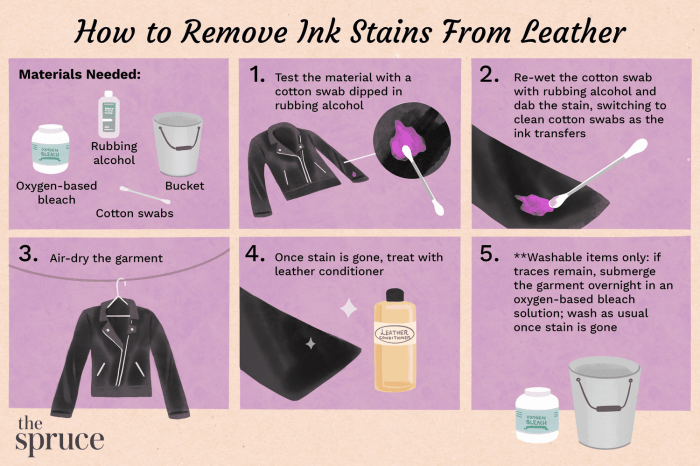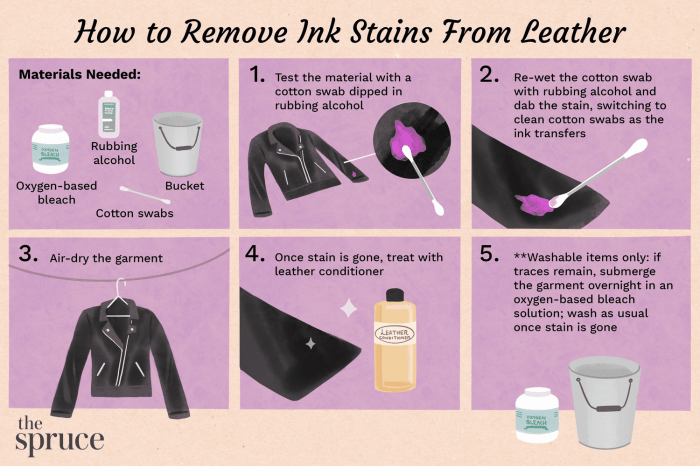
Ink Stains Stink: Tricks to Get Them Out
Ink stains stink tricks to get them out – Ink stains stink: tricks to get them out – a phrase that resonates with anyone who has ever experienced the frustration of a stubborn ink stain. Whether it’s a careless pen swipe on your favorite shirt or a fountain pen mishap on a delicate tablecloth, ink stains can be a real pain to remove.
But fear not, dear reader! This post will delve into the world of ink stain removal, exploring the science behind these pesky marks and arming you with the knowledge and techniques to conquer them.
From prevention strategies to advanced stain removal methods, we’ll cover it all. We’ll also address the unique challenges of removing ink stains from various surfaces, including fabrics, wood, plastic, and leather. So, grab your trusty stain remover, and let’s embark on a journey to banish ink stains from your life!
The Problem
Ink stains are a common and frustrating household problem. Whether it’s a careless pen slip or a leaky fountain pen, these stains can quickly ruin your favorite clothes, furniture, or even your carpet. The persistence of ink stains makes them particularly difficult to remove, often requiring multiple attempts and specialized cleaning solutions.
Ink stains are the worst! They’re so hard to get out, and they always seem to happen at the worst possible time. I’ve tried everything, from soaking in milk to using nail polish remover, but nothing seems to work. Maybe I should check out yard sale tips from the pros to see if they have any secret weapons for getting rid of ink stains.
After all, if they can help you find the perfect vintage furniture at a steal, maybe they can help me conquer these pesky stains too!
Types of Ink Stains
Ink stains can be broadly categorized by the type of ink used. Each type has its unique characteristics and challenges:
- Ballpoint Pen Ink:This type of ink is typically oil-based and contains pigments that are difficult to remove. Ballpoint pen stains are often dark and tend to spread easily, making them particularly stubborn.
- Fountain Pen Ink:Fountain pen ink is typically water-based and contains dyes. While this type of ink is generally easier to remove than oil-based ink, it can still leave behind stubborn stains, especially if allowed to dry completely.
- Permanent Marker Ink:Permanent markers contain alcohol-based inks that are designed to be resistant to fading and water. These stains are notoriously difficult to remove and may require specialized cleaning products or professional help.
Ink and Fabric Interaction
Ink stains are formed when the ink molecules interact with the fibers of the fabric. The ink molecules can penetrate the fabric fibers and become trapped, making removal difficult. The type of fabric and the chemical composition of the ink play a crucial role in how easily the stain can be removed.
For example, natural fibers like cotton and linen are more porous than synthetic fibers like polyester, making them more susceptible to ink penetration.
Advanced Techniques: Ink Stains Stink Tricks To Get Them Out

Sometimes, even the most common ink stain removal methods may not be enough to tackle stubborn stains. For those challenging cases, we delve into more specialized techniques that can be effective on delicate fabrics and persistent ink marks.
Removing Ink Stains from Delicate Fabrics
Removing ink stains from delicate fabrics like silk and wool requires a gentle approach to prevent damage.
Ink stains are the worst! They seem to magically appear on the most prized possessions, like your favorite shirt or your kid’s school uniform. But don’t despair, there are tons of tricks out there to get rid of those pesky stains.
While I’m busy battling ink stains, you can check out all momsense today 15 mothers day ideas for some awesome Mother’s Day gift ideas. And once you’ve found the perfect gift, I’ll be here with more ink stain-fighting tips!
- Cold Water Rinse:Begin by gently rinsing the stained area with cold water. Avoid hot water as it can set the ink, making it harder to remove.
- Mild Detergent Solution:Prepare a solution of mild detergent, like baby shampoo, and cold water. Gently apply this solution to the stain and let it sit for a few minutes. Avoid rubbing, as this can damage the fabric.
- White Vinegar:For stubborn stains, try a diluted solution of white vinegar. Soak a clean cloth in the vinegar solution and gently dab it onto the stain. Remember to test the vinegar on an inconspicuous area of the fabric first to ensure it doesn’t cause any discoloration.
Ink stains are the worst, right? They seem to magically appear on your favorite shirt just when you think you’ve mastered the art of avoiding them. I swear, they’re like the the twirling tooth fairy , but instead of leaving money, they leave a dark, permanent mark.
Luckily, there are some tricks to get them out, and I’ll be sharing them in a future post. Until then, try to keep those pens away from your clothes!
- Professional Cleaning:For extremely delicate fabrics or particularly stubborn stains, it’s best to seek professional cleaning. They have specialized techniques and detergents for handling delicate fabrics.
Using Pre-Treating Agents and Stain Removers
Pre-treating agents and stain removers can be valuable tools in combating stubborn ink stains.
- Pre-Treating Agents:These agents are designed to loosen the ink particles and make them easier to remove. They often contain enzymes that break down the ink molecules. Apply the pre-treating agent to the stain according to the product instructions, and let it sit for the recommended time.
- Stain Removers:Stain removers are formulated to target specific types of stains, including ink. They often contain chemicals that dissolve the ink molecules. Choose a stain remover specifically designed for ink stains and follow the instructions carefully.
Soaking Stained Items in Detergent Solution
Soaking stained items in a detergent solution can help loosen the ink and make it easier to remove.
- Detergent Solution:Prepare a solution of laundry detergent and warm water. Avoid using hot water, as it can set the ink.
- Soaking Time:Soak the stained item in the detergent solution for several hours, or even overnight, depending on the severity of the stain.
- Washing:After soaking, wash the item as usual.
Laundry Care
Once you’ve tackled those ink stains, it’s crucial to prevent further damage to your clothes during the washing process. Proper laundry care is essential to maintain the integrity of your garments and keep them looking their best.
Washing Stained Items Separately
One of the most important steps in laundry care is to wash stained items separately. This is especially important for colored clothing, as it helps prevent color bleeding and ruining other items in the load. Color bleeding occurs when dye from one garment transfers to another, leaving unsightly stains.
By washing stained items separately, you can minimize the risk of this happening.
Selecting the Right Washing Cycle and Water Temperature
The type of fabric and the severity of the stain will determine the appropriate washing cycle and water temperature. Always check the care label on your clothing for specific instructions. For delicate fabrics like silk or lace, use a gentle cycle and cold water.
For sturdier fabrics like cotton or linen, a regular cycle with warm or hot water may be suitable. If you’re unsure, it’s always best to err on the side of caution and use a gentler cycle and cooler water.
Using Fabric Softeners and Dryer Sheets
Fabric softeners and dryer sheets can help to prevent further damage to your clothes. Fabric softeners can make your clothes feel softer and reduce static cling. Dryer sheets can also help to reduce static and wrinkles. However, it’s important to use these products sparingly, as they can build up on your clothes over time and make them less absorbent.
For delicate fabrics, it’s best to avoid fabric softeners and dryer sheets altogether.
Beyond Fabrics
Ink stains can be a frustrating problem, but they’re not limited to fabrics. From wooden furniture to plastic toys, ink can leave its mark on a variety of surfaces. This guide will provide you with techniques and solutions to tackle ink stains on common household materials.
Removing Ink Stains from Wood
Ink stains on wood can be particularly challenging, but with the right approach, they can often be removed. The key is to act quickly and use gentle methods to avoid damaging the wood’s finish.
Always test any cleaning solution on an inconspicuous area of the wood first to ensure it doesn’t cause discoloration or damage.
- For fresh stains:Blot the ink with a clean, dry cloth. Avoid rubbing, as this can spread the stain. If the ink is still wet, you can try using a mild soap solution or rubbing alcohol. Apply a small amount to a clean cloth and gently dab the stain.
Wipe away the residue with a damp cloth.
- For dried stains:Use a paste made of baking soda and water. Apply the paste to the stain and let it sit for several hours. Gently scrub the paste with a soft-bristled brush. Wipe away the residue with a damp cloth.
- For stubborn stains:Consider using a specialized wood cleaner designed for ink removal. Follow the manufacturer’s instructions carefully.
Removing Ink Stains from Plastic
Ink stains on plastic can be easier to remove than on wood. The smooth, non-porous surface of plastic makes it less likely for ink to penetrate deeply.
- For fresh stains:Wipe the ink with a damp cloth. If the ink is still wet, you can try using a mild soap solution or rubbing alcohol. Apply a small amount to a clean cloth and gently dab the stain.
Wipe away the residue with a damp cloth.
- For dried stains:Use a paste made of baking soda and water. Apply the paste to the stain and let it sit for several hours. Gently scrub the paste with a soft-bristled brush. Wipe away the residue with a damp cloth.
- For stubborn stains:Consider using a specialized plastic cleaner designed for ink removal. Follow the manufacturer’s instructions carefully.
Removing Ink Stains from Leather, Ink stains stink tricks to get them out
Ink stains on leather can be challenging to remove, as leather is a delicate material. It’s important to use gentle methods and avoid harsh chemicals.
- For fresh stains:Blot the ink with a clean, dry cloth. Avoid rubbing, as this can spread the stain. If the ink is still wet, you can try using a leather cleaner or a mild soap solution. Apply a small amount to a clean cloth and gently dab the stain.
Wipe away the residue with a damp cloth.
- For dried stains:Use a leather conditioner or a specialized leather cleaner designed for ink removal. Follow the manufacturer’s instructions carefully. Avoid using harsh chemicals or abrasive cleaners.

